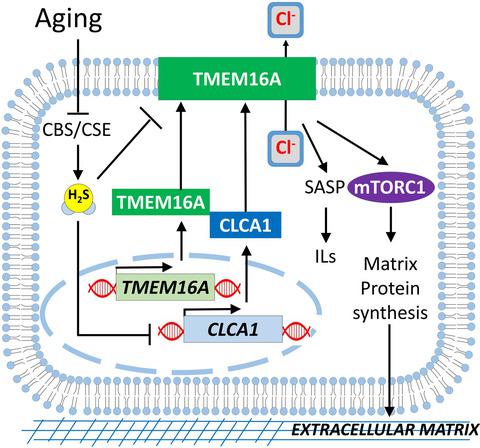当前位置:
X-MOL 学术
›
Aging Cell
›
论文详情
Our official English website, www.x-mol.net, welcomes your
feedback! (Note: you will need to create a separate account there.)
Chloride channel accessory 1 integrates chloride channel activity and mTORC1 in aging-related kidney injury
Aging Cell ( IF 8.0 ) Pub Date : 2021-06-12 , DOI: 10.1111/acel.13407 Hak Joo Lee 1 , Andrew Donati 1 , Denis Feliers 1 , Yuyang Sun 2 , Yanli Ding 3 , Muniswamy Madesh 1 , Adam B Salmon 4, 5, 6, 7 , Yuji Ikeno 3, 4, 6 , Corinna Ross 8, 9 , Christopher L O'Connor 10 , Wenjun Ju 10 , Markus Bitzer 10 , Yidong Chen 11, 12 , Goutam Ghosh Choudhury 1, 6, 7 , Brij B Singh 2 , Kumar Sharma 1, 6 , Balakuntalam S Kasinath 1, 5, 6, 7
Aging Cell ( IF 8.0 ) Pub Date : 2021-06-12 , DOI: 10.1111/acel.13407 Hak Joo Lee 1 , Andrew Donati 1 , Denis Feliers 1 , Yuyang Sun 2 , Yanli Ding 3 , Muniswamy Madesh 1 , Adam B Salmon 4, 5, 6, 7 , Yuji Ikeno 3, 4, 6 , Corinna Ross 8, 9 , Christopher L O'Connor 10 , Wenjun Ju 10 , Markus Bitzer 10 , Yidong Chen 11, 12 , Goutam Ghosh Choudhury 1, 6, 7 , Brij B Singh 2 , Kumar Sharma 1, 6 , Balakuntalam S Kasinath 1, 5, 6, 7
Affiliation

|
The mechanism of kidney injury in aging are not well understood. In order to identify hitherto unknown pathways of aging-related kidney injury, we performed RNA-Seq on kidney extracts of young and aged mice. Expression of chloride (Cl) channel accessory 1 (CLCA1) mRNA and protein was increased in the kidneys of aged mice. Immunostaining showed a marked increase in CLCLA1 expression in the proximal tubules of the kidney from aged mice. Increased kidney CLCA1 gene expression also correlated with aging in marmosets and in a human cohort. In aging mice, increased renal cortical CLCA1 content was associated with hydrogen sulfide (H2S) deficiency, which was ameliorated by administering sodium hydrosulfide (NaHS), a source of H2S. In order to study whether increased CLCA1 expression leads to injury phenotype and the mechanisms involved, stable transfection of proximal tubule epithelial cells overexpressing human CLCA1 (hCLCA1) was performed. Overexpression of hCLCA1 augmented Cl− current via the Ca++-dependent Cl− channel TMEM16A (anoctamin-1) by patch-clamp studies. hCLCA1 overexpression also increased the expression of fibronectin, a matrix protein, and induced the senescence-associated secretory phenotype (SASP). Mechanistic studies underlying these changes showed that hCLCA1 overexpression leads to inhibition of AMPK activity and stimulation of mTORC1 as cellular signaling determinants of injury. Both TMEM16A inhibitor and NaHS reversed these signaling events and prevented changes in fibronectin and SASP. We conclude that CLCA1-TMEM16A-Cl− current pathway is a novel mediator of kidney injury in aging that is regulated by endogenous H2S.
中文翻译:

氯离子通道附件 1 在衰老相关肾损伤中整合氯离子通道活性和 mTORC1
衰老过程中肾损伤的机制尚不清楚。为了确定迄今为止未知的与衰老相关的肾损伤途径,我们对年轻和老年小鼠的肾脏提取物进行了 RNA-Seq。氯离子 (Cl) 通道附件 1 (CLCA1) mRNA 和蛋白质在老年小鼠肾脏中的表达增加。免疫染色显示老年小鼠肾脏近端小管中 CLCLA1 表达显着增加。增加的肾脏 CLCA1 基因表达也与狨猴和人类队列的衰老相关。在衰老小鼠中,肾皮质 CLCA1 含量增加与硫化氢 (H 2 S) 缺乏有关,通过施用硫化氢钠 (NaHS)(一种 H 2的来源)可改善这种情况S. 为了研究增加的 CLCA1 表达是否导致损伤表型及其所涉及的机制,对过表达人 CLCA1 (hCLCA1) 的近端小管上皮细胞进行了稳定转染。hCLCA1 的过表达通过依赖于 Ca ++的 Cl -增强了 Cl -电流通过膜片钳研究通道 TMEM16A (anoctamin-1)。hCLCA1 过表达还增加了基质蛋白纤连蛋白的表达,并诱导衰老相关分泌表型 (SASP)。这些变化背后的机制研究表明,hCLCA1 过表达导致 AMPK 活性的抑制和 mTORC1 的刺激,作为损伤的细胞信号传导决定因素。TMEM16A 抑制剂和 NaHS 都逆转了这些信号传导事件并阻止了纤连蛋白和 SASP 的变化。我们得出结论,CLCA1-TMEM16A-Cl -电流通路是衰老中肾损伤的新介质,受内源性 H 2 S调节。
更新日期:2021-07-16
中文翻译:

氯离子通道附件 1 在衰老相关肾损伤中整合氯离子通道活性和 mTORC1
衰老过程中肾损伤的机制尚不清楚。为了确定迄今为止未知的与衰老相关的肾损伤途径,我们对年轻和老年小鼠的肾脏提取物进行了 RNA-Seq。氯离子 (Cl) 通道附件 1 (CLCA1) mRNA 和蛋白质在老年小鼠肾脏中的表达增加。免疫染色显示老年小鼠肾脏近端小管中 CLCLA1 表达显着增加。增加的肾脏 CLCA1 基因表达也与狨猴和人类队列的衰老相关。在衰老小鼠中,肾皮质 CLCA1 含量增加与硫化氢 (H 2 S) 缺乏有关,通过施用硫化氢钠 (NaHS)(一种 H 2的来源)可改善这种情况S. 为了研究增加的 CLCA1 表达是否导致损伤表型及其所涉及的机制,对过表达人 CLCA1 (hCLCA1) 的近端小管上皮细胞进行了稳定转染。hCLCA1 的过表达通过依赖于 Ca ++的 Cl -增强了 Cl -电流通过膜片钳研究通道 TMEM16A (anoctamin-1)。hCLCA1 过表达还增加了基质蛋白纤连蛋白的表达,并诱导衰老相关分泌表型 (SASP)。这些变化背后的机制研究表明,hCLCA1 过表达导致 AMPK 活性的抑制和 mTORC1 的刺激,作为损伤的细胞信号传导决定因素。TMEM16A 抑制剂和 NaHS 都逆转了这些信号传导事件并阻止了纤连蛋白和 SASP 的变化。我们得出结论,CLCA1-TMEM16A-Cl -电流通路是衰老中肾损伤的新介质,受内源性 H 2 S调节。











































 京公网安备 11010802027423号
京公网安备 11010802027423号